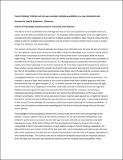Files in this item
Future thinking : children but not apes consider multiple possibilities
Item metadata
| dc.contributor.author | Seed, Amanda Madeleine | |
| dc.contributor.author | Dickerson, Katherine Leah | |
| dc.date.accessioned | 2017-07-11T23:34:02Z | |
| dc.date.available | 2017-07-11T23:34:02Z | |
| dc.date.issued | 2016-07-11 | |
| dc.identifier | 247319553 | |
| dc.identifier | 68ff5f37-bd41-499a-a35e-3381b2f68f92 | |
| dc.identifier | 000384799500006 | |
| dc.identifier | 84979742249 | |
| dc.identifier | 000384799500006 | |
| dc.identifier.citation | Seed , A M & Dickerson , K L 2016 , ' Future thinking : children but not apes consider multiple possibilities ' , Current Biology , vol. 26 , no. 13 , pp. R525-R527 . https://doi.org/10.1016/j.cub.2016.05.022 | en |
| dc.identifier.issn | 0960-9822 | |
| dc.identifier.other | ORCID: /0000-0002-3867-3003/work/60426873 | |
| dc.identifier.uri | https://hdl.handle.net/10023/11187 | |
| dc.description.abstract | When anticipating the future, we draw on our past experience but must take uncertainty into account; for example, while preparing for a trip, we might pack a raincoat and sunglasses because of unpredictable weather. New research shows that the ability to plan for multiple future possibilities may be present in human children from as early as 3–4 years of age, but appears to be lacking in non-human apes. | |
| dc.format.extent | 4 | |
| dc.format.extent | 58194 | |
| dc.language.iso | eng | |
| dc.relation.ispartof | Current Biology | en |
| dc.subject | Mental time-travel | en |
| dc.subject | Pan-troglodytes | en |
| dc.subject | Foresight | en |
| dc.subject | Animals | en |
| dc.subject | Unique | en |
| dc.subject | Young | en |
| dc.subject | Task | en |
| dc.subject | BF Psychology | en |
| dc.subject.lcc | BF | en |
| dc.title | Future thinking : children but not apes consider multiple possibilities | en |
| dc.type | Journal item | en |
| dc.contributor.institution | University of St Andrews. School of Psychology and Neuroscience | en |
| dc.contributor.institution | University of St Andrews. ‘Living Links to Human Evolution’ Research Centre | en |
| dc.contributor.institution | University of St Andrews. Institute of Behavioural and Neural Sciences | en |
| dc.contributor.institution | University of St Andrews. Centre for Social Learning & Cognitive Evolution | en |
| dc.identifier.doi | 10.1016/j.cub.2016.05.022 | |
| dc.description.status | Peer reviewed | en |
| dc.date.embargoedUntil | 2017-07-11 |
This item appears in the following Collection(s)
Items in the St Andrews Research Repository are protected by copyright, with all rights reserved, unless otherwise indicated.

